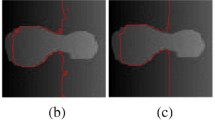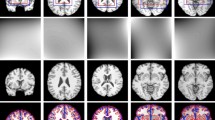Abstract
Magnetic resonance (MR) image segmentation plays an essential role for brain disease diagnosis; however, suffered from low contrast, intensity inhomogeneity, noise and asymmetry of the intensity distribution, segmentation methods are always difficult to achieve satisfactory results. In this paper, we propose a novel level set method for brain MR image segmentation with consideration of these problems. We firstly generate a new region descriptor based on asymmetric Gaussian distributions in order to fit different shapes of observed nonsymmetric data. Secondly, we utilize the spatial distance and intensity similarity information of neighborhood pixels to extract local anisotropic spatial information to balance the noise reduction and detail preservation. After that, the extracted information and bias field information are combined to improve the asymmetric region descriptor utilized in the level set framework. Finally, we define a maximum likelihood energy functional on the whole image, integrating the local anisotropic spatial information, the bias field information and the asymmetric distributions. The experimental results on synthetic and clinical images demonstrated that our method can achieve desirable performance in spite of the severe noise and intensity inhomogeneity.













Similar content being viewed by others
References
Işın, A., Direkoğlu, C., Şah, M.: Review of MRI-based brain tumor image segmentation using deep learning methods. Proc. Comput. Sci. 102, 317–324 (2016)
Wang, L., Shi, F., Yap, P.T., et al.: Longitudinally guided level sets for consistent tissue segmentation of neonates. Hum. Brain Mapp. 34(4), 956–972 (2013)
Kass, M., Witkin, A., Terzopoulos, D.: Snakes: active contour models. Int. J. Comput. Vis. 1(4), 321–331 (1988)
Osher, S., Sethian, J.A.: Fronts propagating with curvature-dependent speed: algorithms based on Hamilton-Jacobi formulations. J. Comput. Phys. 79(1), 12–49 (1988)
Gupta, D., Anand, R.S.: A hybrid edge-based segmentation approach for ultrasound medical images. Biomed. Signal Process. Control 31, 116–126 (2017)
Suganthi, S.S., Ramakrishnan, S.: Anisotropic diffusion filter based edge enhancement for segmentation of breast thermogram using level sets. Biomed. Signal Process. Control 10(1), 128–136 (2014)
Wang, X.F., Min, H., Zhang, Y.G.: Multi-scale local region based level set method for image segmentation in the presence of intensity inhomogeneity. Neurocomputing 151, 1086–1098 (2015)
Chan, T.F., Vese, L.A.: Active contours without edges. IEEE Trans. Image Process. 10(2), 266–277 (2001)
Li, C., Kao, C.Y., Gore, J.C., et al.: Minimization of region-scalable fitting energy for image segmentation. IEEE Trans. Image Process. 17(10), 1940–1949 (2008)
Li, C., Huang, R., Ding, Z., et al.: A level set method for image segmentation in the presence of intensity inhomogeneities with application to MRI. IEEE Trans. Image Process. 20(7), 2007–2016 (2011)
Wang, Li, Chen, Yunjie, Ding, Zhaohua, Xia, Deshen: Level set segmentation of brain magnetic resonance images based on local Gaussian distribution fitting energy. J. Neurosci. Methods 188(2), 316–325 (2010)
Wang, Li, Shi, Feng, Lin, Weili, Gilmore, John H., Shen, Dinggang: Automatic segmentation of neonatal images using convex optimization and coupled level sets. NeuroImage 58, 805–817 (2011)
Chen, Y., Zhao, B., Zhang, J., et al.: Automatic segmentation for brain MR images via a convex optimized segmentation and bias field correction coupled model. Magn. Reson. Imag. 32(7), 941–955 (2014)
Zhang, K., Zhang, L., Lam, K.M., et al.: A level set approach to image segmentation with intensity inhomogeneity. IEEE Trans. Cybern. 46(2), 546–557 (2015)
Meng, X., Gu, W., Chen, Y., et al.: Brain MR image segmentation based on an improved active contour model. PLoS ONE 12(8), e0183943 (2017)
Brox, T.: From pixels to regions: partial differential equations in image analysis, Ph.D. dissertation, Dept. Comput. Sci., Saarland University, Saarbrücken, Germany (2005)
Nguyen, T.M., Jonathan Wu, Q.M., Mukherjee, D., Zhang, H.: A Bayesian bounded asymmetric mixture model with segmentation application. IEEE J. Biomed. Health Inform. 18, 109–119 (2014)
Xu, Y., Géraud, T., Bloch, I.: From neonatal to adult brain MR image segmentation in a few seconds using 3D-like fully convolutional network and transfer learning. In: IEEE International Conference on Image Processing (ICIP), pp. 4417–4421 (2017)
You, X., Peng, Q., Yuan, Y., et al.: Segmentation of retinal blood vessels using the radial projection and semi-supervised approach. Pattern Recogn. 44(10–11), 2314–2324 (2011)
Khowaja, S.A., Khuwaja, P., Ismaili, I.A.: A framework for retinal vessel segmentation from fundus images using hybrid feature set and hierarchical classification. SIViP 13, 379–387 (2019)
Huang, L., Zhao, Y., Yang, T.: Skin lesion segmentation using object scale-oriented fully convolutional neural networks. SIViP 13, 431–438 (2019)
Wells III, W.M., Grimson, W.E.L., Kikinis, R., et al.: Adaptive segmentation of MRI data. IEEE Trans. Med. Imag. 15(4), 429–442 (1996)
Caldairou, B., Passat, N., Habas, P.A., et al.: A non-local fuzzy segmentation method: application to brain MRI. Pattern Recogn. 44(9), 1916–1927 (2011)
Chen, Y., Zhang, H., Zheng, Y., et al.: An improved anisotropic hierarchical fuzzy c-means method based on multivariate student t-distribution for brain MRI segmentation. Pattern Recognit. 60(C), 778–792 (2016)
Coupé, P., Yger, P., Prima, S., et al.: An optimized blockwise nonlocal means denoising filter for 3-D magnetic resonance images. IEEE Trans. Med. Imag. 27(4), 425–441 (2008)
Li, C., Gatenby, C., Wang, L., Gore, J.C.: A robust parametric method for bias field estimation and segmentation of MR images. In: CVPR 2009, pp. 218–223
Niu, S., Chen, Q., Sisternes, L.D., et al.: Robust noise region-based active contour model via local similarity factor for image segmentation. Pattern Recogn. 61, 104–119 (2016)
Shi, F., Wang, L., Dai, Y., et al.: LABEL: pediatric brain extraction using learning-based meta-algorithm. Neuroimage 62(3), 1975–1986 (2012)
Van Leemput, K., Maes, F., Vandermeulen, D., et al.: Automated model-based bias field correction of MR images of the brain. IEEE Trans. Med. Imaging 18(10), 885–896 (1999)
Li, C., Gore, J.C., Davatzikos, C.: Multiplicative intrinsic component optimization (MICO) for MRI bias field estimation and tissue segmentation. Mag. Reson. Imag. 32(7), 913–923 (2014)
Acknowledgements
This work was supported in part by the National Nature Science Foundation of China 61672291, 61701222, in part by the Nature Science Foundation of the Jiangsu Higher Education Institutions of China under Grant No. 17KJB510026.
Author information
Authors and Affiliations
Corresponding author
Ethics declarations
Conflict of interest
The authors declare that they have no conflict of interest.
Additional information
Publisher’s Note
Springer Nature remains neutral with regard to jurisdictional claims in published maps and institutional affiliations.
Rights and permissions
About this article
Cite this article
Chen, Y., Wu, M. A level set method for brain MR image segmentation under asymmetric distributions. SIViP 13, 1421–1429 (2019). https://doi.org/10.1007/s11760-019-01491-8
Received:
Revised:
Accepted:
Published:
Issue Date:
DOI: https://doi.org/10.1007/s11760-019-01491-8




